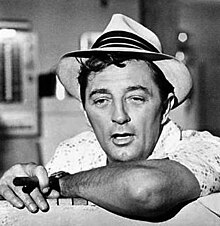I never saw this one, my grandparents told me this version was scarier.........
Contents
After spending eight years in prison for
rape,
Max Cady (
Robert Mitchum) is released. He promptly tracks down Sam Bowden (
Gregory Peck), a
Georgia lawyer whom he holds personally responsible for his conviction because Sam interrupted his attack and testified against him. Cady begins to stalk and subtly threaten Bowden's family. He kills the Bowden family dog, though Sam cannot prove Cady did it. A friend of Bowden's, police chief Mark Dutton (
Martin Balsam), attempts to intervene on Bowden's behalf, but he cannot prove Cady guilty of any crime.
Bowden hires Charlie Sievers (
Telly Savalas), a private detective. Cady brutally attacks a young,
promiscuous woman named Diane Taylor (
Barrie Chase) when she brings him home, but neither the private eye nor Bowden can persuade her to testify. Bowden hires three thugs to beat up Cady and persuade him to leave town, but the plan backfires when Cady gets the better of all three. Cady's lawyer vows to have Bowden disbarred.
Afraid for his wife Peggy (
Polly Bergen) and 14-year-old daughter Nancy (
Lori Martin), Bowden takes them to their houseboat in
Cape Fear. In an attempt to trick Cady, Bowden makes it seem as though he has gone to a completely different location. He fully expects Cady to follow his wife and daughter, and he plans on killing Cady to end the battle. He and a local deputy hide nearby, but Cady realizes the deputy is there and kills him. Eluding Bowden, Cady first attacks Mrs. Bowden on the boat, causing Bowden to go to her rescue. Meanwhile, Cady swims back to shore to attack the daughter. Bowden realizes what has happened and also swims ashore.
The two men engage in a final violent fight on the riverbank. Bowden overpowers Cady but decides not to kill him, preferring to let him spend the rest of his life in jail. The film ends with the Bowden family sitting together on a boat the next morning.
Production[edit]
Casting[edit]
Almost everyone in Hollywood wanted a role in the film.
Rod Steiger wanted to play Max Cady, but he backed off when he heard Mitchum was considering the role.
Telly Savalas was screentested for the role but later played private eye Charlie Sievers.
[1]
Filming[edit]

Robert Mitchum in
Cape Fear
Thompson had always envisioned the film in black and white prior to production. As an
Alfred Hitchcock fan, he wanted to have
Hitchcockian elements in the film, such as unusual lighting angles, an eerie musical score, closeups, and subtle hints rather than graphic depictions of the violence Cady has in mind for the family.
The outdoor scenes were filmed on location in
Savannah, Georgia,
Stockton, California, and the Universal Studios backlot at
Universal City, California. The indoor scenes were done at Universal Studios Soundstage. Mitchum had a real-life aversion to Savannah, where as a teenager, he had been charged with vagrancy and put on a
chain gang. This resulted in a number of the outdoor scenes' being shot at Ladd's Marina in Stockton, including the culminating conflict on the houseboat at the end of the movie.
This scene where Mitchum attacks Polly Bergen's character on the houseboat was almost completely improvised. Before the scene was filmed, Thompson suddenly told a crew member: "Bring me a dish of eggs!" Mitchum's rubbing the eggs on Bergen was not scripted and Bergen's reactions were real. She also suffered back injuries from being knocked around so much. She felt the impact of the "attack" for days.
[2] While filming the scene, Mitchum cut open his hand, leading Bergen to recall: "his hand was covered in blood, my back was covered in blood. We just kept going, caught up in the scene. They came over and physically stopped us."
[3]
In the source novel
The Executioners, by
John D. MacDonald, Cady was a soldier
court-martialed and convicted on then Lieutenant Bowden's testimony for the brutal rape of a 14-year-old girl. The censors stepped in, banned the use of the word "rape", and stated that depicting Cady as a soldier reflected adversely on U.S. military personnel.
[citation needed]
Bernard Herrmann, as often in his scores, uses a reduced version of the symphony orchestra. Here, other than a 46-piece string section (slightly larger than usual for film scores), he adds 4
flutes (doubling on 2
piccolos, 2
alto flutes in G, and 2
bass flutes in C), and 8
French Horns. No use is made of further wind instruments or percussion.
[4]
Distribution[edit]
Although the word "rape" was entirely removed from the script before shooting, the film still enraged the censors, who worried that "there was a continuous threat of sexual assault on a child." In order to accept the film, British censors required extensive editing and deleting of specific scenes. After making around 6 minutes of cuts, the film still nearly garnered a British X rating (meaning at the time, "Suitable for those aged 16 and older", not necessarily meaning there was pornographic content).
[citation needed]
Home media[edit]
Cape Fear was first made available on VHS on March 1, 1992. It was later re-released on VHS as well as DVD on September 18, 2001. Currently, the film is set to be released onto
Blu-rayon January 8, 2013. It will contain production photos as well as a "making-of" featurette.
[5]
Reaction[edit]

No comments:
Post a Comment